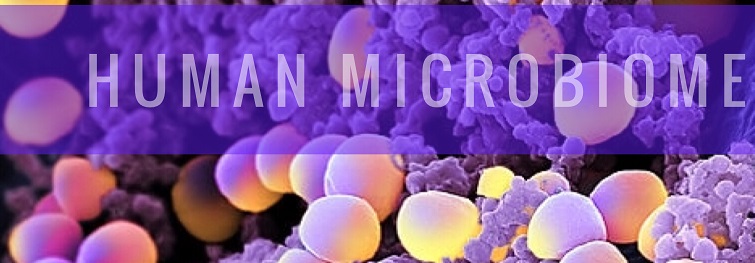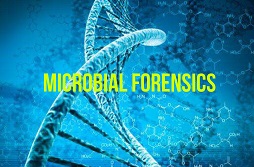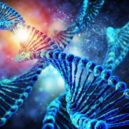The human Microbiome- A new rising star in forensics

If Sir Arthur Conan Doyle were to be alive today , the famous detective Sherlock Holmes created by him, who was credited for being a paradigmatic forensic expert for utilising fingerprints, hairs and blood samples to solve crimes would have prodigiously cracked most of the complicated crime cases using microscopic traces of bacteria left behind by the criminals. Believe it or not ! The microbial community present on each individual called the “ Microbiome “ is the new fingerprint.
We are at the beginning of a voyage, and this voyage promises to revolutionise criminal investigation all over the Earth. When we are born we are mostly sterile but we acquire microbes from our mother and the environment during the birth and after the birth. We acquire approximately 10000 different strains of bacteria and this species composition remains mostly stable for the rest of the life of a human being .We start with approximately 20500 genes at birth but over length of time we acquire in excess of 1000000 genes. We have as a matter of fact 10 times more bacterial cells than human cells, which makes us wonder whether we are in actuality human beings or microbial beings ? The microorganisms alone account for approximately 1 to 1.5 kgs of our body mass.The human body also gives off a mind-blowing 36 million microbes into the his surroundings every hour. These microbial signatures are what the forensic scientists exploit to chase down suspects and identify people in murders, burglaries and sexual assaults. This is what makes it a robust profiling tool as well as the most promising emerging tool in the world of forensics.
 One typical summer morning, microbiologist Jose Lopez was having coffee in the courtyard of his house when two burglars burst into his house, ransacked the almirahs, had a Coke from the refrigerator and disconnected the TV to carry it. This was not a real burglary. This was a set up. The burglars where employees at the local sheriff’s office and the burglary was part of an experimental project. After the burglary, the forensic experts dived on the scene to swab down surfaces, handles and the house. After eliminating the bacterial signatures left behind by the household inmates and the pet cat, they were left with new physical evidence, the microbial signatures left by the thieves.
One typical summer morning, microbiologist Jose Lopez was having coffee in the courtyard of his house when two burglars burst into his house, ransacked the almirahs, had a Coke from the refrigerator and disconnected the TV to carry it. This was not a real burglary. This was a set up. The burglars where employees at the local sheriff’s office and the burglary was part of an experimental project. After the burglary, the forensic experts dived on the scene to swab down surfaces, handles and the house. After eliminating the bacterial signatures left behind by the household inmates and the pet cat, they were left with new physical evidence, the microbial signatures left by the thieves.
The bacterial signatures of the two intruders did not just reveal their identity but it also revealed their lifestyle habits when it was stacked up against a database of few thousand people. The comparison divulged that one of the burglars had at least ten alcoholic drinks a week while the other was on a migraine medication. The microbiome left at the scene also has the capacity to surmise whether the perpetrator is a man or a woman, his / her weight, ethnicity, whether he smokes or drinks etc. These kinds of leads could be very valuable for police.
 A study published in 2010 in the “ Proceedings of the National Academy of Sciences “, illustrated that DNA recovered from computer keyboards and owners fingertips matched with one another. The authors are also able to scrape out bacteria from nine computer mice and correctly pinpoint the owners of the computer mice by contrasting it with a database of 270 microbiome available on the public domain. Everybody’s poop has a unique signature. Harvard University conducted a study on stool samples collected from participants in the study. A year later they found the bacteria signatures collected from the stools of the participants helped researchers identify individuals with 86% accuracy. Skin bacteria are found peoples mobile phones. The microbial profile of a person obtained from the cell phone can be used to link the phone to its original owner with 97% accuracy using only the swabs taken from the phones.
A study published in 2010 in the “ Proceedings of the National Academy of Sciences “, illustrated that DNA recovered from computer keyboards and owners fingertips matched with one another. The authors are also able to scrape out bacteria from nine computer mice and correctly pinpoint the owners of the computer mice by contrasting it with a database of 270 microbiome available on the public domain. Everybody’s poop has a unique signature. Harvard University conducted a study on stool samples collected from participants in the study. A year later they found the bacteria signatures collected from the stools of the participants helped researchers identify individuals with 86% accuracy. Skin bacteria are found peoples mobile phones. The microbial profile of a person obtained from the cell phone can be used to link the phone to its original owner with 97% accuracy using only the swabs taken from the phones.
 The germs picked by the soles of the shoe of the accused at a crime scene could land him in jail. Microbiologist Jack Gilbert and his team at the Argonne National Laboratory in Chicago have shown that bacteria sticking to the sole of the shoe could tell the crime scene investigators where one has been.In a sexual assault crime, the microbiota left behind by a suspect on a victim could link the specific body part. Microbiome communities differ across different geographical locations due to variations in climate, altitude and rainfall. Specific knowledge of specific microbiomes can help in specifying specific geographic locations. This can help in child trafficking cases. It would be possible to connect children trafficked from Nepal into India through microbiome geographical signatures including possible intermediate locations such as Bihar through which the child was trafficked. Buildings in different places have different bacterial signatures, a suspect from Chennai carrying out a homicide in a house in Mumbai could be linked to the crime through microbiome profiling. China appears to have solved a case of murder entirely on microbial profiling. The soil on the shovel recovered from the accused had a bacterial profile similar to the soil isolated from the grave site connecting the accused to the murder.
The germs picked by the soles of the shoe of the accused at a crime scene could land him in jail. Microbiologist Jack Gilbert and his team at the Argonne National Laboratory in Chicago have shown that bacteria sticking to the sole of the shoe could tell the crime scene investigators where one has been.In a sexual assault crime, the microbiota left behind by a suspect on a victim could link the specific body part. Microbiome communities differ across different geographical locations due to variations in climate, altitude and rainfall. Specific knowledge of specific microbiomes can help in specifying specific geographic locations. This can help in child trafficking cases. It would be possible to connect children trafficked from Nepal into India through microbiome geographical signatures including possible intermediate locations such as Bihar through which the child was trafficked. Buildings in different places have different bacterial signatures, a suspect from Chennai carrying out a homicide in a house in Mumbai could be linked to the crime through microbiome profiling. China appears to have solved a case of murder entirely on microbial profiling. The soil on the shovel recovered from the accused had a bacterial profile similar to the soil isolated from the grave site connecting the accused to the murder.
In India, the Bangalore police are reported to have solved a murder by analyzing the microbial traces left behind by an accused. A 57-year-old woman was murdered in her house in Jayanagar and her valuables stolen. Tilak Nagar police were clueless about the murder for a long time. Then the Forensic Science Laboratory’s report came along indicating the presence of bacteria and fungus in a sample collected from the scene. This together with the CCTV footage pointed to a rag picker as the microbes collected from the scene matched with those on the rag picker. This eventually lead to his arrest and detection of the case.
Microbes play an important role in the decomposition of human corpses and scientists are exploring the use of microbial succession during the decomposition to estimate the time since death and as an indicator for locating unknown graves. In a healthy human being, the brain, liver spleen and heart are free from microflora. Our immune system hinders the microbes from getting into these organs. But after death, microorganisms spread into these germ-free organs. The migration of microbial microorganisms into the sterile organs can be a pretty accurate measure of post-mortem interval, a duration which enables investigators to arrive at the time of death.
The microbial signature technique could become a new tool in the arsenal of law enforcement alongside DNA fingerprinting and physical fingerprinting. When the physical fingerprints are smudged and the suspect has not left behind DNA, bacterial fingerprints can go to the aid of the investigator although DNA will always be the gold standard. Bacterial signatures have several advantages over diagnostic DNA evidence. Unless the suspect has left behind blood, tissue, semen, saliva, hair etc it is often difficult to obtain sufficient DNA for forensic identification but microbes on the contrary are abundant and it’s much easier to recover bacterial DNA than human DNA. It is also easier to recover bacterial DNA than human DNA from touch surfaces and on the other hand bacterial DNA are available in most scenarios than human DNAs . Cosmetics, antibiotics usage, dietary changes and health states could have a corresponding change in the microbiome . This is one of the drawbacks of bacterial signatures.
While human bacterial fingerprinting should never replace traditional DNA fingerprinting, it’s possible it could augment the existing techniques available with the forensic scientists. Any introduction of new technique would require amendments to criminal laws and establishment of standards governing collection and use of samples. Substantial investment would be needed in standardisation and implementation of detection techniques that could automate and hasten microbiome profiling .This could also entail maintenance of databases which could raise privacy issues, as the databases could reveal if a person is carrying a sexually transmitted disease or suffering some other chronic disease, it could also reveal his associations, the number of sexual partners he or she has had as well as his drug habits and addictions. The database could also be used to connect people to crime by showing evidence by way of the places he has visited, his familial origin, ethnicity etc. Therefore advances in next-generation sequencing could turn microbes into a powerful tool for criminal investigation.
Source from: epaper/deccanchronicle/chennai/dt:16.08.2018 & 20.08.2018
 Dr.K. Jayanth Murali is an IPS Officer belonging to 1991 batch. He is borne on Tamil Nadu cadre. He lives with his family in Chennai, India. He is currently serving the Government of Tamil Nadu as Additional Director General of Police, DVAC.
Dr.K. Jayanth Murali is an IPS Officer belonging to 1991 batch. He is borne on Tamil Nadu cadre. He lives with his family in Chennai, India. He is currently serving the Government of Tamil Nadu as Additional Director General of Police, DVAC.


